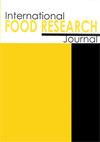Influence of selected lactic acid bacteria on the sensory characteristics of soft cheese with natural rind
IF 0.7
4区 农林科学
Q4 FOOD SCIENCE & TECHNOLOGY
引用次数: 0
Abstract
Cheese is obtained by the coagulation of milk, followed by maturation under the action of microorganisms which are responsible for the development of physicochemical and organoleptic characteristics of cheese. Among various microorganisms, lactic acid bacteria (LAB) play an essential role in establishing sensory characteristics of the cheese. In Cameroon, the effect of isolated LAB on the sensory characteristics of cheese produced from local cow milk has not yet been investigated. Therefore, the present work aimed to isolate LAB and evaluate their influence on the physicochemical and sensory characteristics of locally produced soft cheeses. Four strains of LAB were isolated and identified as Enterococcus sp.1, Enterococcus sp.2, Pediococcus sp., and Leuconostoc sp. These isolates were combined in batches for production of cheeses, including Frm 741 (Enterococcus sp.1 and Enterococcus sp.2), Frm 891 (Enterococcus sp.2 and Leuconostoc sp.), Frm 683 (Pediococcus sp. and Enterococcus sp.1), Frm 425 (Pediococcus sp. and Leuconostoc sp.), Frm 503 (Pediococcus sp. and Enterococcus sp.2), Frm 439 (Leuconostoc sp. and Enterococcus sp.1), and Frm 625 (Enterococcus sp.1, Enterococcus sp.2, Leuconostoc sp., and Pediococcus sp.). Cheese produced from the combination of Enterococcus sp.1 and Enterococcus sp.2 (Frm 741), unlike the others, did not drain properly throughout the production process. However, all products showed excellent microbiological quality in relation to biological contaminants, such as Salmonella, staphylococci, and coliforms. Moreover, cheese Frm 425 was most appreciated by consumers for its sweet taste, yellow colour, pleasant smell, and low acidity (51.7°D). On the other hand, cheese Frm 439 was least appreciated by consumers owing to its bad odour, bitter taste, and high acidity (144.9°D). Taken together, the present work demonstrated that the isolated LAB could be used to produce soft cheese with a natural rind and unique sensory characteristics that are appreciated by Cameroonian consumers.选定乳酸菌对天然带皮软质干酪感官特性的影响
奶酪是通过牛奶的凝固,然后在微生物的作用下成熟而得到的,微生物负责奶酪的物理化学和感官特性的发展。在多种微生物中,乳酸菌对奶酪感官特性的形成起着至关重要的作用。在喀麦隆,分离的乳酸菌对当地牛奶生产的奶酪感官特性的影响尚未进行调查。因此,本研究旨在分离乳酸菌,并评估其对当地生产的软质奶酪的理化和感官特性的影响。分离得到4株乳酸菌,鉴定为肠球菌sp.1、肠球菌sp.2、Pediococcus sp.和Leuconostoc sp.。这些分离物分批合并用于奶酪生产,包括741株(肠球菌sp.1和肠球菌sp.2)、891株(肠球菌sp.2和Leuconostoc sp.)、683株(Pediococcus sp.和Enterococcus sp.1)、425株(Pediococcus sp.和Leuconostoc sp.1)、503株(Pediococcus sp.和enterostoc sp.2)、439株(Leuconostoc sp.1和Leuconostoc sp.1)。625株(肠球菌sp.1,肠球菌sp.2,白色球菌sp.和Pediococcus sp.)。由肠球菌sp.1和肠球菌sp.2组合生产的奶酪(来自741),与其他奶酪不同,在整个生产过程中不能正常排水。然而,所有产品在生物污染物方面都表现出良好的微生物质量,如沙门氏菌、葡萄球菌和大肠菌群。此外,425号奶酪最受消费者喜爱的是它的甜味、黄色、宜人的气味和低酸度(51.7°D)。另一方面,439号奶酪因其难闻的气味、苦味和高酸度(144.9°D)而最不受消费者喜爱。综上所述,目前的工作表明,分离的乳酸菌可以用来生产软质奶酪,这些奶酪具有天然的外皮和独特的感官特征,受到喀麦隆消费者的欢迎。
本文章由计算机程序翻译,如有差异,请以英文原文为准。
求助全文
约1分钟内获得全文
求助全文
来源期刊

international food research journal
Agricultural and Biological Sciences-Food Science
CiteScore
1.40
自引率
0.00%
发文量
75
期刊介绍:
The International Food Research Journal (IFRJ) publishes papers in English, six (6) issues a year with the coverage of:
Food Science and Technology
Nutrition and Dietetics
Agriculture, multidisciplinary
Chemistry, multidisciplinary
The scope of the Journal includes:
Food Science, Food Technology and Food Biotechnology
Product Development and Sensory Evaluation
Food Habits, Nutrition, and Health
Food Safety and Quality
Food Chemistry, Food Microbiology, Food Analysis and Testing
Food Engineering
Food Packaging
Food Waste Management
Food Entrepreneur
Food Regulatory
Post-Harvest Food Management
Food Supply Chain Management
Halal Food and Management
 求助内容:
求助内容: 应助结果提醒方式:
应助结果提醒方式:


